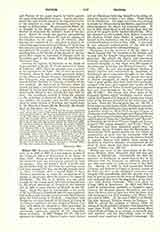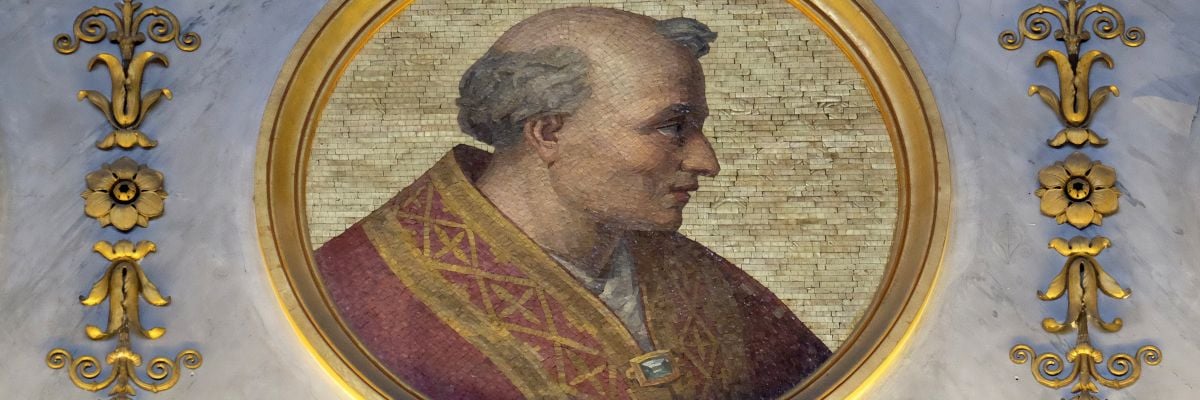

Victor III, BLESSED, POPE (DAUFERIUS or DAUFAR), b. in 1026 or 1027 of a non-regnant branch of the Lombard dukes of Benevento; d. in Rome, September 16, 1087. Being an only son his desire to embrace the monastic state was strenuously opposed by both his parents. After his father’s death in battle with the Normans, 1047, he fled from the marriage which had been arranged for him and though brought back by force, eventually after a second flight to Cava obtained permission to enter the monastery of S. Sophia at Benevento where he received the name of Desiderius. The life at S. Sophia was not strict enough for the young monk who betook himself first to the island monastery of Tremite in the Adriatic and in 1053 to some hermits at Majella in the Abruzzi. About this time he was brought to the notice of St. Leo IX and it is probable that the pope employed him at Benevento to negotiate peace with the Normans after the fatal battle of Civitate. Somewhat later Desiderius attached himself to the Court of Victor II at Florence and there met two monks of Monte Cassino, with whom he returned to their monastery in 1055. He joined the community, and was shortly afterwards appointed superior of the dependent house at Capua. In 1057 Stephen IX (X) who had retained the abbacy of Monte Cassino came thither and at Christmas, believing himself to be dying, ordered the monks to elect a new abbot. Their choice fell on Desiderius. The pope recovered, and, desiring to retain the abbacy during his lifetime, appointed the abbot-designate his legate for Constantinople. It was at Bari, when about to sail for the East, that the news of the pope’s death reached Desiderius. Having obtained a safe-conduct from Robert Guiscard, the Norman Count (later Duke) of Apulia, he returned to his monastery and was duly installed by Cardinal Humbert on Easter Day, 1058. A year later he was ordained cardinal-priest of the title of S. Cecelia and received the abbatial blessing.
Desiderius was the greatest of all the abbots of Monte Cassino with the exception of the founder, and as such won for himself “imperishable fame” (Gregorovius). He rebuilt the church and conventual buildings, established schools of art and reestablished monastic discipline so that there were 200 monks in the monastery in his day (see Abbey of Monte Cassino). On October 1, 1071, the new and magnificent Basilica of Monte Cassino was consecrated by Alexander II. Desiderius’s great reputation brought to the abbey many gifts and exemptions. The money was spent on church ornaments of which the most notable were a great golden altar front from Constantinople, adorned with gems and enamels and “nearly all the church ornaments of Victor II which had been pawned here and there throughout the city” [Chron. Cass., III, 18 (20)]. The bronze and silver doors of the Cassinese Basilica which Desiderius erected remain, and in the Church of S. Angelo in Formis near Capua some of the frescoes executed by his orders may still be seen. Peter the Deacon gives (op. cit., III, 63) a list of some seventy books which Desiderius caused to be copied at Monte Cassino; they include works of Sts. Augustine, Ambrose, Bede, Basil, Jerome, Gregory of Nazianzus, and Cassian, the registers of Popes Felix and Leo, the histories of Josephus, Paul Warnfrid, Jordanus, and Gregory of Tours, the “Institutes” and “Novels” of Justinian, the works of Terence, Virgil, and Seneca, Cicero’s “De natura deorum”, and Ovid’s “Fasti”.
Desiderius had been appointed papal vicar for Campania, Apulia, Calabria, and the Principality of Beneventum with special powers for the reform of monasteries; so great was his reputation with the Holy See that he “was allowed by the Roman Pontiff to appoint Bishops and Abbots from among his brethren in whatever churches or monasteries he desired of those which had been widowed of their patron” (Chron. Cas., III, 34).
Within two years of the consecration of the Cassinese Basilica, Pope Alexander died and was succeeded by Hildebrand. Undoubtedly the chief importance of Desiderius in papal history lies in his influence with the Normans, an influence which he was able repeatedly to exert in favor of the Holy See. Already in 1059 he had persuaded Robert Guiscard and Richard of Capua to become vassals of St. Peter for their newly conquered territories: now Gregory VII immediately after his election sent for him to give an account of the state of Norman Italy and entrusted him with the negotiation of an inter-view with Robert Guiscard. This took place on August 2, 1073, at Benevento. In 1074 and 1076 he acted as intermediary, probably as Gregory’s agent, between the Norman princes themselves, and even when the latter were at open war with the pope, they still maintained the best relations with Monte Cassino (end of 1076). At the end of 1080 it was Desiderius who obtained Norman troops for Gregory. In 1082 he visited the emperor at Albano, while the troops of the Imperialist antipope were harassing the pope from Tivoli. In 1083 the peace-loving abbot joined Hugh of Cluny in an attempt to reconcile pope and emperor, and his proceedings seem to have aroused some suspicion in Gregory’s entourage. In 1084 when Rome was in Henry’s hands and the pope besieged in Sant’ Angelo, Desiderius announced the approach of Guiscard’s army to both emperor and pope.
Though certainly a strong partisan of the Hildebrandine reform the gentler Desiderius belonged to the moderate party and could not always see eye to eye with Gregory in his most intransigeant proceedings. Yet when the latter lay dying at Salerno (May 25, 1085) the Abbot of Monte Cassino was one of those whom he named as fittest to succeed him. Desiderius was by no means willing to assume the mantle of Gregory VII, experience had taught him that his power and utility lay in being a middleman, yet at a time when the Church was surrounded by powerful enemies his influence with the Normans made him the most obvious candidate. The Romans had expelled the antipope from the city, and hither Desiderius hastened to consult with the cardinals on the approaching election; finding, however, that they were bent on forcing the papal dignity upon him he fled to Monte Cassino, where he busied himself in exhorting the Normans and Lombards to rally to the support of the Holy See. When autumn came Desiderius accompanied the Norman army in its march towards Rome, but becoming aware of the plot which was on foot between the cardinals and the Norman princes to force the tiara upon him, he would not enter Rome unless they swore to abandon their design; this they refused to do, and the election was postponed. At about Easter (Chron. Cass., III, 66) the bishops and cardinals assembled at Rome summoned Desiderius and the cardinals who were with him at Monte Cassino to come to Rome to treat concerning the election. On May 23 a great meeting was held in the deaconry of St. Lucy, and Desiderius was again importuned to accept the papacy but persisted in his refusal, threatening to return to his monastery in case of violence. Next day, the feast of Pentecost, very early in the morning the same scene was repeated. The consul Cencius now suggested the election of Odo, Cardinal–Bishop of Ostia (afterwards Urban II), but this was rejected by some of the cardinals on the ground that the translation of a bishop was contrary to the canons. The assembly now lost all patience; Desiderius was seized and dragged to the Church of St. Lucy where he was forcibly vested in the red cope and given the name of Victor (May 24, 1086). The Church had been without a head for twelve months all but a day. Four days later pope and cardinals had to flee from Rome before the imperial prefect of the city, and at Terracina, in spite of all protests, Victor laid aside the papal insignia and once more retired to Monte Cassino where he remained nearly a whole year. In the middle of Lent, 1087, a council of cardinals and bishops was held at Capua at which the pope-elect assisted as “Papal vicar of those parts” (letter of Hugh of Lyons) together with the Norman princes, Cencius the Consul, and the Roman nobles; here Victor finally yielded and “by the assumption of the cross and purple confirmed the past election” (Chron. Cass., III, 68). How much his obstinacy had irritated some of the prelates is evidenced in the letter of Hugh of Lyons preserved by Hugh of Flaviony (Mon. Germ. Hist.: Script. VIII, 466-8).
After celebrating Easter in his monastery Victor proceeded to Rome, and when the Normans had driven the soldiers of the Antipope Clement III (Guibert of Ravenna) out of St. Peter’s, was there consecrated and enthroned (May 9, 1087). He only remained eight day* in Rome and then returned to Monte Cassino. Before May was out he was once more in Rome in answer to a summons from the Countess Matilda, whose troops held the Leonine City and Trastevere, but when at the end of June the antipope once more gained possession of St. Peter’s, Victor again retired to his abbey. In Au-gust a council was held at Benevento, at which he renewed the excommunication of the antipope and the condemnation of lay-investiture, and anathematised Hugh of Lyons and Richard, Abbot of Marseilles. When the council had lasted three days Victor became seriously ill and retired to Monte Cassino to die. He had himself carried into the chapter-house, issued various decrees for the benefit of the abbey, appointed with the consent of the monks the prior, Cardinal Oderisius, to succeed him in the Abbacy, just as he himself had been appointed by Stephen IX (X), and proposed Odo of Ostia to the assembled cardinals and bishops as the next pope. He died September 16, 1087, and was buried in the tomb he had prepared for himself in the chapter-house. In the sixteenth century his body was removed to the church, and again translated in 1890. The cultus of Blessed Victor seems to have begun not later than the pontificate of Anastasius IV, about 60 years after his death (Acta SS. be. cit.). In 1727 the Abbot of Monte Cassino obtained from Benedict III permission to keep his feast (Tosti, I, 393).
Pope Victor III is a far less impressive figure in history than Desiderius the great Abbot of Monte Cassino, but there is abundant evidence that it was largely his failing health that made him so reluctant to accept the great position which was thrust upon him, indeed Ordericus tells us that he was taken ill when saying the first Mass after his consecration, so that during his papacy “he hardly got through one single Mass”, vix una tantum missa perfunctus (P.L., CLXXXVIII, p. 578). On August 5, 1087, when Victor was holding the Council at Benevento, an army consisting of Roman, Genoese, Pisan, and Amalfitan troops sent by him to Africa under the Banner of St. Peter captured the town of El Mahadia, and forced the Mohammedan ruler of Tunis to promise tribute to the Holy See and to free all Christian slaves. This event may perhaps be considered as the beginning of the Crusades. The only literary work of Victor which we possess is his “Dialogues” on the miracles wrought by St. Benedict and other saints at Monte Cassino. There is also a letter to the bishops of Sardinia to which country he had sent monks while still Abbot of Monte Cassino. In his “De Viris illustribus Casinensibus,” Peter the Deacon ascribes to him the composition of a”Cantus ad B. Maurum” and letters to Philip of France and Hugh of Cluny which no longer exist.
RAYMUND WEBSTER


